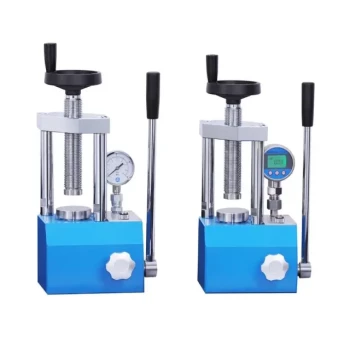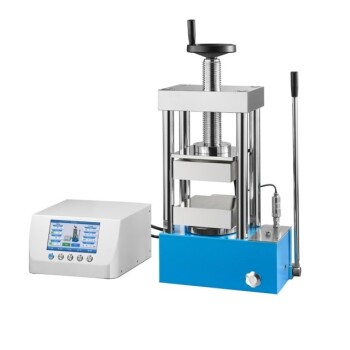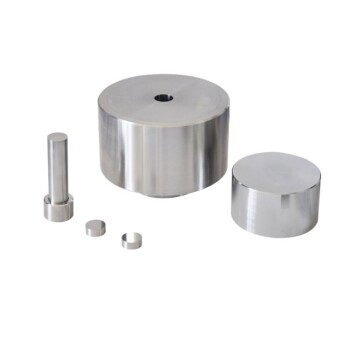At its core, a hydraulic press operates on a fundamental law of fluid mechanics known as Pascal's Principle. This principle states that when pressure is applied to an enclosed, incompressible fluid, that pressure is transmitted equally and undiminished to all parts of the fluid and the walls of its container. This elegant concept is the key to how a small, manageable input force can be transformed into an immense output force.
The central mechanism of a hydraulic press is not the creation of energy, but the amplification of force. It achieves this by applying a small force over a large distance on a small piston, which is then converted into a massive force exerted over a short distance by a much larger piston.
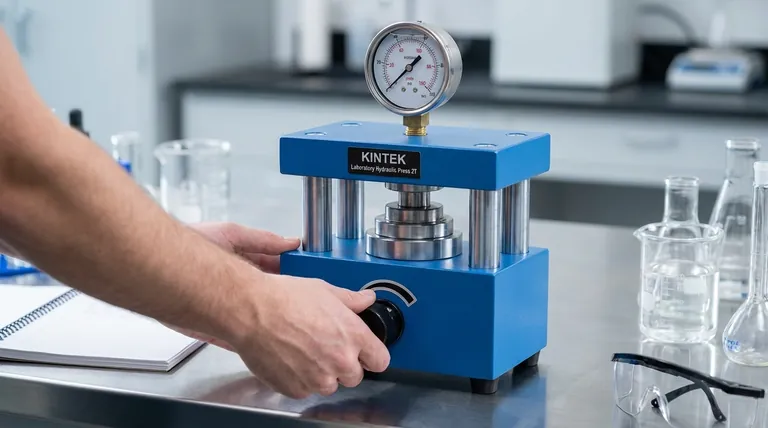
The Core Mechanism: Understanding Pascal's Principle
The entire operation hinges on the relationship between pressure, force, and area. By manipulating these variables within a sealed hydraulic system, we can achieve remarkable force multiplication.
What is Pascal's Principle?
Pascal's Principle is the scientific foundation for all hydraulic systems. Imagine squeezing a sealed water bottle; the pressure you apply with your hand is felt equally everywhere inside the bottle.
This law dictates that pressure (P) in a confined fluid is constant throughout. Pressure is defined as Force (F) applied per unit of Area (A), or P = F/A.
The Force Amplification Formula
Because the pressure is equal on both sides of a sealed system, the pressure on the input piston (P1) must equal the pressure on the output piston (P2).
This gives us the equation: F1 / A1 = F2 / A2.
If the output piston has a surface area 100 times greater than the input piston, the output force will be 100 times greater than the input force. This is the source of the press's power.
The Role of the Incompressible Fluid
Hydraulic systems use specialized oils because they are nearly incompressible. This is critical.
When force is applied, the fluid does not compress and lose volume. Instead, it efficiently transmits the pressure directly from the input piston to the output piston, ensuring the force is transferred with minimal energy loss.
How a Hydraulic Press Translates Principle to Power
A hydraulic press is a physical embodiment of Pascal's law, consisting of a few key components working in concert.
The Input Piston (Effort)
This is the smaller piston where an initial, relatively small force is applied, typically by a pump. This action pressurizes the hydraulic fluid within the system.
The Output Piston (Load)
Also known as the ram, this is the much larger piston. The pressure generated by the input piston acts across this large surface area, creating a proportionally larger output force that performs the work of stamping, crushing, or forming.
The Hydraulic System
The pistons are connected by pipes filled with hydraulic fluid. A pump provides the initial force, a reservoir holds the fluid, and a series of valves control the fluid's direction, allowing the ram to extend, retract, and hold its position with precision.
Understanding the Trade-offs: Force vs. Distance
The force multiplication provided by a hydraulic press is not "free energy." It comes with a necessary and fundamental trade-off dictated by the laws of physics.
The Conservation of Energy
A hydraulic press cannot create more energy than is put into it. The work done (Force × Distance) on the input side is equal to the work done on the output side, ignoring minor efficiency losses.
The Distance Compromise
To generate a massive output force, that force can only be exerted over a very short distance.
Conversely, the small input force must be applied over a much longer distance. To move the large output piston by one inch, the small input piston might have to travel 100 inches. This is why hydraulic presses are powerful but often not exceptionally fast.
Safety and Control
The immense forces generated necessitate robust safety features. Systems are equipped with pressure relief valves to prevent overloading and catastrophic failure. Interlocking safety guards are also common to protect operators during the press cycle.
Common Applications Across Industries
The ability to deliver a massive, controlled force makes hydraulic presses indispensable tools in nearly every sector of modern industry.
Manufacturing and Metal Forming
These presses are workhorses for stamping, forging, and bending metal parts. Their power allows them to shape thick sheets of steel and other alloys with precision.
Automotive and Aerospace
In the automotive industry, they are used to form body panels and press bearings into place. In aerospace, they shape high-strength components like turbine blades that must meet exacting tolerances.
Compression and Assembly
Hydraulic presses are used for powder compacting to create solid parts from metallic or ceramic powders, as well as for compression molding of plastics and rubber. They are also used for assembly operations like riveting and crimping.
Making the Right Choice for Your Goal
Understanding the principle behind the press allows you to appreciate its specific strengths and limitations for any given task.
- If your primary focus is raw power: Pascal's principle allows you to generate immense output forces from a small input by simply engineering a large difference between piston areas.
- If your primary focus is precision control: Hydraulic systems offer a smooth, even, and highly controllable application of force, essential for forming delicate parts or performing precise assembly tasks.
- If your primary focus is operational speed: Remember the trade-off. Generating high force requires displacing a large volume of fluid, which fundamentally limits the ram's maximum speed.
By mastering the transfer of pressure, the simple hydraulic press turns a fundamental principle of physics into a cornerstone of industrial power.
Summary Table:
| Principle | Key Component | Function |
|---|---|---|
| Pascal's Principle | Hydraulic Fluid | Transmits pressure equally in a confined system |
| Force Amplification | Input Piston | Applies small force over large distance |
| Output Power | Output Piston | Generates large force over short distance |
| Applications | Various Industries | Used in metal forming, powder compacting, and assembly |
Unlock the power of hydraulic technology for your laboratory needs! KINTEK specializes in lab press machines, including automatic lab presses, isostatic presses, and heated lab presses, designed to deliver precise force control and efficiency for tasks like material testing and sample preparation. Our expertise ensures reliable performance tailored to your specific requirements. Contact us today to discuss how our solutions can enhance your lab's capabilities and drive your projects forward!
Visual Guide
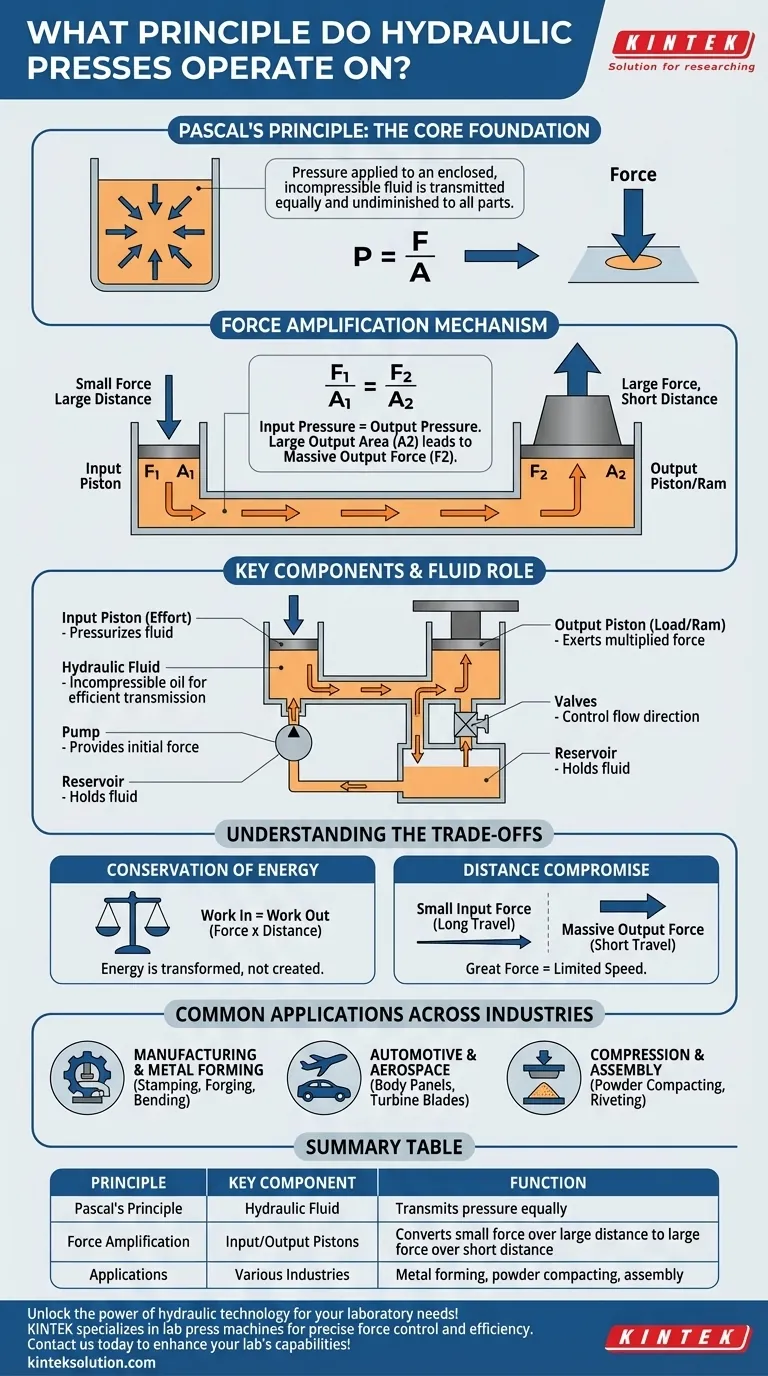
Related Products
- Laboratory Hydraulic Press 2T Lab Pellet Press for KBR FTIR
- Automatic Laboratory Hydraulic Press Lab Pellet Press Machine
- Manual Heated Hydraulic Lab Press with Integrated Hot Plates Hydraulic Press Machine
- Laboratory Hydraulic Press Lab Pellet Press Button Battery Press
- Manual Laboratory Hydraulic Press Lab Pellet Press
People Also Ask
- What are some laboratory applications of hydraulic presses? Boost Precision in Sample Prep and Testing
- What are the main advantages of using hydraulic presses for sample preparation? Achieve Precise, Uniform Samples for Reliable Analysis
- What is the purpose of making KBr pellets in the lab? Achieve High-Sensitivity FTIR Analysis for Accurate Results
- What are the advantages of using the hydraulic portable press for making KBr pellets? Achieve Superior FT-IR Sample Prep
- How do hydraulic press machines ensure precision and consistency in pressure application? Achieve Reliable Force Control for Your Lab






